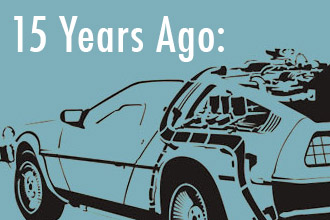15 Years Ago: Bluetooth? What’s Bluetooth?
It’s incredible that Gary’s first explanation of Bluetooth is 15 years old! What’s interesting to note is that this year’s CES has finally cemented “The Internet of Things,” which was one of the originally marketed purposes of Bluetooth but didn’t really catch on until recently. Early Bluetooth’s problems were due to a much shorter range than advertised, as well as huge speed and bandwidth issues. One-way Bluetooth audio slowly and steadily brought Bluetooth into the mainstream with now-ubiquitous cellphone headsets. Within the last couple years, two-way Bluetooth has made connecting your phone to an external car system convenient and functional. LE Bluetooth (Low Power Bluetooth) is an exciting new development as it allows for a continuous connection to user’s mobile devices without any connecting or hand-shaking required. It will change the way retail store function and PayPal is leading the way with Beacon. — Matt Cooper
 Bluetooth? What’s Bluetooth?
Bluetooth? What’s Bluetooth?
By Gary Kayye, CTS
If you haven’t heard of the new technology called Bluetooth, you will. Bluetooth is about to invade the consumer electronics world with the promise of creating the rapid demise of IR (infrared) while giving virtually anything from cars to refrigerators the ability to communicate to each other via direct connectivity or the Internet.
What is Bluetooth? Well, Bluetooth is the codename for a new technology specification for small form factor, low-cost, short-range radio links between mobile PCs, mobile phones and other portable devices. Bluetooth can transmit through solid, non-metal objects. Its nominal link range is from 10 centimeters to 10 meters, but can be extended to 100 meters by increasing the transmit power. If all goes well, Bluetooth will enable users to connect a wide range of computing and telecommunications devices easily and simply, without the need to buy, carry, or connect cables. It delivers opportunities for rapid ad hoc connections, and the possibility of automatic, unconscious, connections between devices. The Bluetooth SIG Special Interest Group (made up of corporations like Intel, Microsoft, Ericsson, IBM and Nokia) claims it will virtually eliminate the need to purchase proprietary cabling to connect individual devices (i.e. speaker cables, printer cables and even control cables).
So, what does this have to do with ProAV?
Well, nothing YET, but since Bluetooth is a bi-directional RF type signal, it’s logical that consumer and professional electronics gear, who’s primary communications methodology is IR, stands to gain quite a bit from Bluetooth, In fact, if you look at a list of over 1,000 members of the Bluetooth SIG, you see prominent ProAV manufacturers like Telex, Mitsubishi, Philips, InFocus, Sanyo, Sony, Sharp, and NEC. Hmm, interesting, huh?
What’s the biggest hassle in connectivity today? Communications standards. Sure, we have RS232 as the preferred communications standard integrated into ProAV gear, some consumer electronics gear and the control systems of today (Panja [2014 editor’s note: err — AMX] and Crestron) but no two companies use the same 232 code or command streams. So, that means connectivity confusion.
Bluetooth promises to eliminate that. Its communications protocol is standard, it’s bi-directional and if the Bluetooth SIG has their way, it’s going to co-exist an almost everything that plugs into the wall to get power; making them compatible and capable of talking to each other.
Now, I don’t necessarily see the need to have my refrigerator tell me when it missing something — (actually, the application is cool. The refrigerator detects that you have walked into a grocery store — since your PDA (e.g., PalmPilot, etc.) in your pocket knows that — and tells you that you are low on milk and eggs and reminds you that your light bulb in your bathroom is burned out and you need to buy a replacement one. And, since your car is in the parking lot of the grocery store it also reminds you that you still need to replace the break light fuse so why don’t you go next door to the K-Mart and get a fuse) — but I do like the theory that simply by powering up electronics gear within 30 feet of each other they can communicate to each other. Sure, it’s a bit more complicated than that, but you get the idea. One thing is for sure, it will certainly render that useless IrDA port on your laptop (you know, the IR port that no one uses) to the round-file. I love the idea of being able to connect my laptop to anything, anywhere without lugging around a bag full of cables. (By the way, have you noticed that in the hype to build and market a projector under the 5 pound category that all the manufacturers are conveniently forgetting to tell you how much your “actual” weight will be with over 2 pounds of cables).
I applaud this. I think it’s a lot like the strategy that both Panja (formerly AMX) and Crestron have taken with Internet control and connectivity, but Bluetooth is certainly going to have a positive impact. Now, you don’t need to run out and buy a Bluetooth handbook nor do you need to spread the rumor that Gary Kayye thinks that Bluetooth is the ultimate communications protocol; it simply represents progress that I, along with a host of AV installers, designers and manufacturers can appreciate.
If you want to learn more about Bluetooth, join the Bluetooth SIG or simply track the progress of Bluetooth as it develops, point your browser here.
By the way, are you wondering where the name Bluetooth came from? Well, it was named after a 10th Century Danish king that had a dead-tooth (hence Bluetooth) and was famous for uniting his kingdoms. The Bluetooth consortium is trying to unite the world communications standard.





